Lessico
Agata
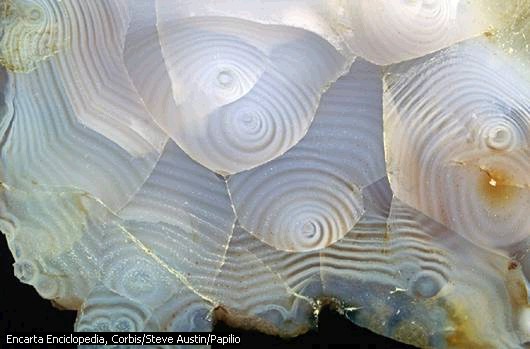
Agata
deriva dal greco achátës. Si tratta di un minerale, di una varietà di calcedonio![]() ,
composto cioè di silice (SiO2),
caratterizzato da una struttura a zone concentriche di colore variabile,
opache e trasparenti. Il colore è dovuto alla presenza di sali di ferro e può
essere verde, rosso, azzurro, nero o biancastro.
,
composto cioè di silice (SiO2),
caratterizzato da una struttura a zone concentriche di colore variabile,
opache e trasparenti. Il colore è dovuto alla presenza di sali di ferro e può
essere verde, rosso, azzurro, nero o biancastro.
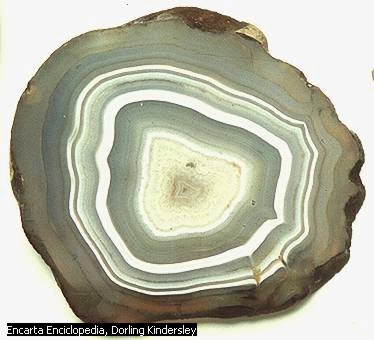
Quando il
contrasto cromatico delle zone è molto forte, il minerale è detto onice![]() .
L'agata si forma entro piccole cavità di rocce basiche per sedimentazione
ritmica di silice gelatinosa. Il minerale può presentarsi in tipi diversi: si
parla di agata arborizzata (o pietra albero o pietra di Mokka) quando le
inclusioni, costituite da ossidi di ferro o di manganese, hanno forma
dendritica; di agata muschiosa (o pietra muschio o calcedonio verde), quando
si hanno inclusioni a ciuffo di asbesto verdastro; di agata corniola
.
L'agata si forma entro piccole cavità di rocce basiche per sedimentazione
ritmica di silice gelatinosa. Il minerale può presentarsi in tipi diversi: si
parla di agata arborizzata (o pietra albero o pietra di Mokka) quando le
inclusioni, costituite da ossidi di ferro o di manganese, hanno forma
dendritica; di agata muschiosa (o pietra muschio o calcedonio verde), quando
si hanno inclusioni a ciuffo di asbesto verdastro; di agata corniola![]() quando è
formata in gran parte da strie rosse di corniola; di agata sarda quando è
formata in prevalenza da zone di colore bruno, costituite dalla varietà di
calcedonio nota come sarda
quando è
formata in gran parte da strie rosse di corniola; di agata sarda quando è
formata in prevalenza da zone di colore bruno, costituite dalla varietà di
calcedonio nota come sarda![]() ;
di agata diaspro quando strie di agata si alternano a strie di diaspro di
colore verde scuro.
;
di agata diaspro quando strie di agata si alternano a strie di diaspro di
colore verde scuro.
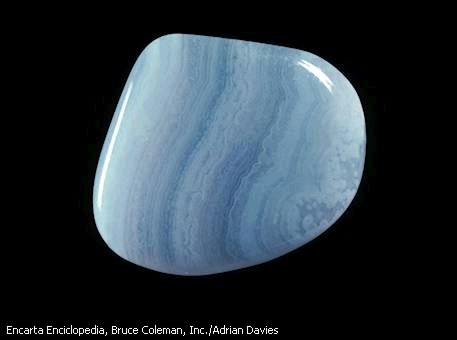
I giacimenti più ricchi sono quelli del Brasile, dell'Uruguay, dell'India e del Madagascar. Famoso è il fiume Acate, oggi detto Dirillo, in cui si rinveniva agata in abbondanza e dalla quale ha tratto il nome. Il Dirillo ha una lunghezza di 52 km, un bacino 680 kmq e si trova nella Sicilia meridionale. Nasce con il nome di Dirillo dal monte Marineo, nel settore nord-occidentale dei Monti Iblei, attraversa la piana di Noto e sfocia nel golfo di Gela.
Di uso frequente nell'antichità – si trovano alcuni sigilli in questa pietra – nei sec. XVI-XVII se ne ricavarono coppe e altri oggetti ornamentali, mettendo sempre in rilievo il carattere della striatura. È usata anche in gioielleria, secondo il tipico taglio a cabochon. Una lavorazione che ne mette in risalto le differenti zone di colore è quella cosiddetta a cammeo. Diversi preziosi oggetti di agata, tra i quali un bellissimo vaso mediceo databile intorno al 1575, sono conservati al Museo degli Argenti a Firenze.
Agate is a microcrystalline variety of quartz (silica), chiefly chalcedony, characterised by its fineness of grain and brightness of color. Although agates may be found in various kinds of rock, they are classically associated with volcanic rocks but can be common in certain metamorphic rocks. Colorful agates and other chalcedonies were obtained over 3,000 years ago from the Achates River (so called because of the stone), now called Dirillo, in Sicily.
The stone was given its name by Theophrastus, a Greek philosopher and naturalist, who discovered the stone along the shore line of the river Achates sometime between the 4th and 3rd centuries BC.
Formation and characteristics
Most agates occur as nodules in volcanic rocks or ancient lavas where they represent cavities originally produced by the disengagement of volatiles in the molten mass which were then filled, wholly or partially, by siliceous matter deposited in regular layers upon the walls. Such agates, when cut transversely, exhibit a succession of parallel lines, often of extreme tenuity, giving a banded appearance to the section. Such stones are known as banded agate, riband agate and striped agate.
In the formation of an ordinary agate, it is probable that waters containing silica in solution -- derived, perhaps, from the decomposition of some of the silicates in the lava itself -- percolated through the rock and deposited a siliceous coating on the interior of the vapour-vesicles. Variations in the character of the solution or in the conditions of deposition may cause a corresponding variation in the successive layers, so that bands of chalcedony often alternate with layers of crystalline quartz. Several vapour-vesicles may unite while the rock is still viscous, and thus form a large cavity which may become the home of an agate of exceptional size; thus a Brazilian geode lined with amethyst and weighing 67 tons was exhibited at the Dusseldorf Exhibition of 1902. Perhaps the most comprehensive review of agate chemistry is a recent text by Moxon cited below.
The first deposit on the wall of a cavity, forming the "skin" of the agate, is generally a dark greenish mineral substance, like celadonite, delessite or "green earth", which are rich in iron probably derived from the decomposition of the augite in the enclosing volcanic rock. This green silicate may give rise by alteration to a brown iron oxide (limonite), producing a rusty appearance on the outside of the agate-nodule. The outer surface of an agate, freed from its matrix, is often pitted and rough, apparently in consequence of the removal of the original coating. The first layer spread over the wall of the cavity has been called the "priming", and upon this base zeolitic minerals may be deposited.
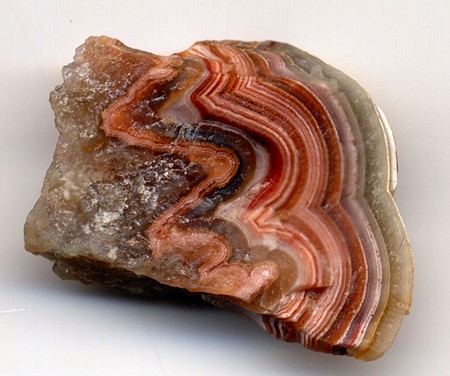
Banded
agate (agate-like onyx).
The specimen is 2.5 cm (1 inch) wide.
Many agates are hollow, since deposition has not proceeded far enough to fill the cavity, and in such cases the last deposit commonly consists of quartz, often amethyst, having the apices of the crystals directed towards the free space so as to form a crystal-lined cavity, or geode.
On the disintegration of the matrix in which the agates are embedded, they are set free. The agates are extremely resistant to weathering and remain as nodules in the soil or are deposited as gravel in streams and shorelines.
Types of agate
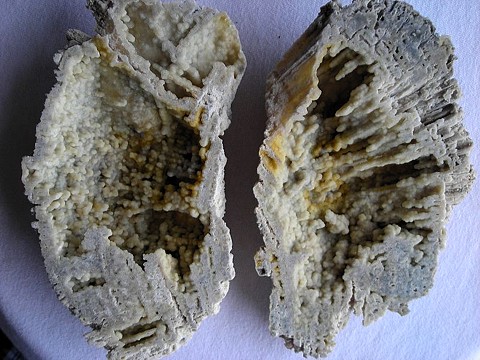
Agatized Coral
A Mexican agate, showing only a single eye, has received the name of "cyclops agate." Included matter of a green, golden, red, black or other color or combinations embedded in the chalcedony and disposed in filaments and other forms suggestive of vegetable growth, gives rise to dendritic or moss agate (named varieties include Maury Mountain, Marston Ranch, Sheep Creek and others). Dendritic agates have beautiful fern like patterns on them formed due to the presence of manganese and iron oxides. Other types of included matter deposited during agate-building include sagenitic growths (radial mineral crystals) and chunks of entrapped detritus (such as sand, ash, or mud). Occasionally agate fills a void left by decomposed vegetative material such as a tree limb or root and is called limb cast agate due to its appearance.
Turritella agate is formed from fossil Turritella shells silicified in a chalcedony base. Turritella are spiral marine gastropods having elongated, spiral shells composed of many whorls. Similarly, coral, petrified wood and other organic remains or porous rocks can also become agatized. Agatized coral is often referred to as Petoskey agate or stone.
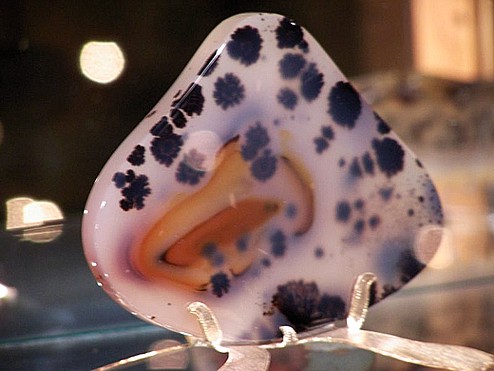
Montana Moss Agate
California's
"Mojave Blue" agate has gained a great deal of attention in the past
several years. This pastel blue or blue-gray agate cuts into attractive
cabochons for jewelry and, in the hands of an expert carver, makes outstanding
carvings.
Greek agate is a name given to pale white to tan colored agate found in Sicily
back to 400 BC. The Greeks used it for making jewelry and beads. Today any
agate of this color from Sicily, once an ancient Greek colony, is called Greek
agate. Yet the stone had been around centuries before that and was known to
both the Sumerians and the Egyptians, who used the gem for decoration and
religious ceremony.
Another
type of agate is Brazilian agate, which is found as sizable geodes of layered
nodules. These occur in brownish tones interlayered with white and gray.
Quartz forms within these nodules, creating a striking specimen when cut
opposite the layered growth axis. It is often dyed in various colors for
ornamental purposes.
Certain stones, when examined in thin sections by transmitted light, show a
diffraction spectrum due to the extreme delicacy of the successive bands,
whence they are termed rainbow agates. Often agate coexists with layers or
masses of opal, jasper or crystalline quartz due to ambient variations during
the formation process.
Other forms of agate include carnelian agate (usually exhibiting reddish hues), Botswana agate, Ellensburg blue agate, blue lace agate, plume agates (such as Carey, Graveyard Point, Sage, St. Johns, Teeter Ranch and others), tube agate (with visible flow channels), fortification agate (which exhibit little or no layered structure), fire agate (which seems to glow internally like an opal) and Mexican crazy-lace agate (which exhibits an often brightly colored, complex banded pattern) also called Rodeo Agate and Rosetta Stone depending on who owned the mine at the time.
Agate beliefs
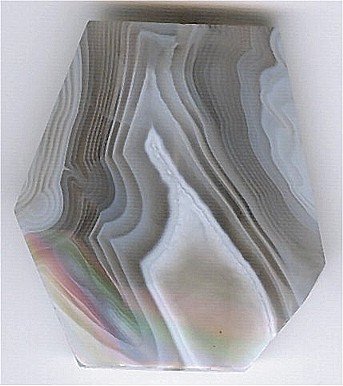
Faceted Botswana agate
In many traditions agate is believed to cure the stings of scorpions and the bites of snakes, soothe the mind, prevent contagion, still thunder and lightning, promote eloquence, secure the favour of the powerful, and bring victory over enemies.[citation needed] Persian magi are also known to have prized agate rings in their work and beliefs.
Some followers of Pagan religions also believe agate is a crystal whose powers can be used for love, mental clarity, and good luck in card games.
Uses in industry
Industry uses agates chiefly to make ornaments such as pins, brooches, paper knives, inkstands, marbles and seals. Because of its hardness and ability to resist acids, agate is used to make mortars and pestles to crush and mix chemicals. Because of the high polish possible with agate it has been used for centuries for leather burnishing tools.